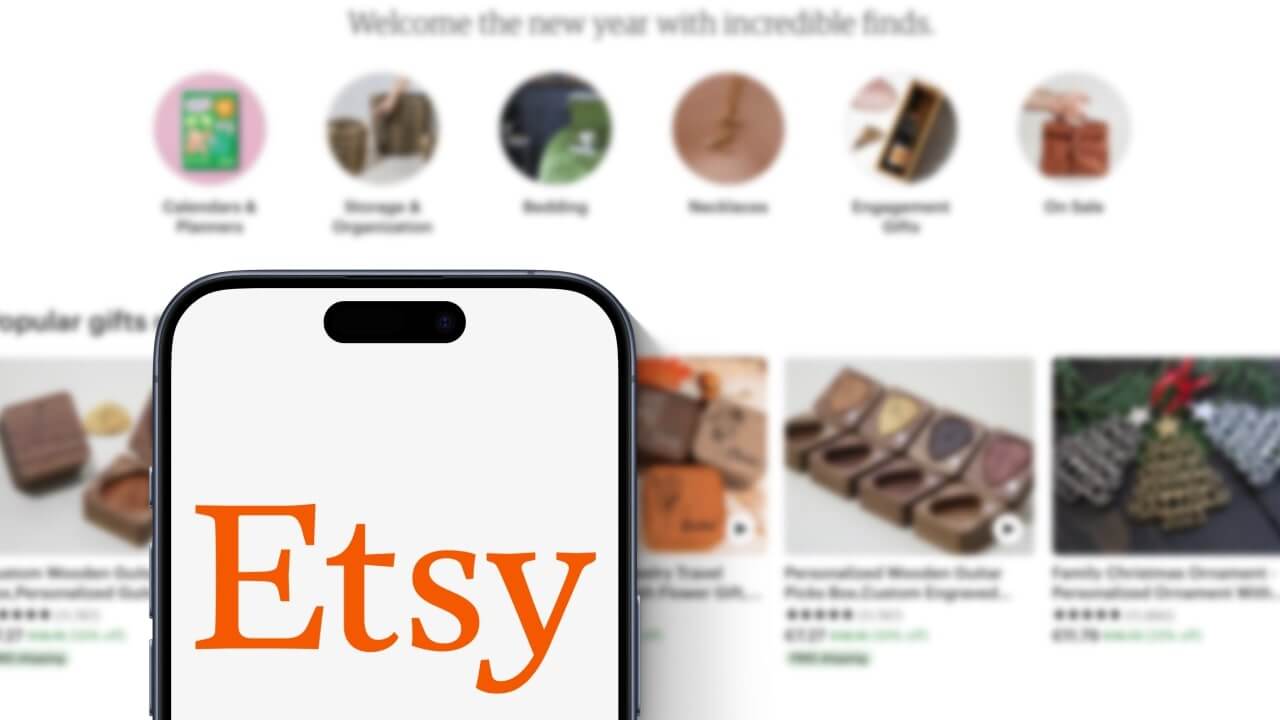Sell custom products with Printify
Asking yourself, “Is selling on Etsy worth it?” Many signs point to yes! Etsy is a go-to spot for over 90 million shoppers looking for unique and handmade products, making it a prime sales channel for both big and small business owners.
This article covers everything you need to determine if this marketplace is right for your business, from navigating Etsy costs and setting good profit margins to targeting the right niche markets. We’ll examine the pros and cons to help you make the best decision for your online store.
Is selling on Etsy worth it in 2026?
With millions of shoppers and an active seller community, the Etsy marketplace remains a promising platform for making money online in 2026, but that doesn’t mean it’s guaranteed to be the best option for your own store or handmade business.
So, is it worth it to sell on Etsy for you? Let’s find out.
Who is Etsy for?
Etsy is for artists, crafters, designers, and vintage enthusiasts to sell their products. It’s the go-to platform for creative people who value authenticity and personalized shopping experiences.
If you want to kickstart a creative business selling custom, vintage, or handmade items, Etsy may be a worthwhile choice for your store.
Key stats
Independent sellers are the primary vendors on the Etsy marketplace, showing its focus on small businesses. The platform boasted a combined $2.7 billion in revenue in 2023 and moves upward yearly, with sales peaking during the holiday season.
While Etsy’s popularity and massive audience provide great opportunities to sellers, it also means you’ll face fierce competition and have to work hard to stand out.
In 2024, roughly 9 million active sellers were on the marketplace publishing listings. You’ll need to work hard on marketing and listing optimization to win shoppers’ sales.
Best-selling items on Etsy
If you sell items in popular categories, it is worth selling on Etsy to reach a larger audience.
eRank Trends says that these are the best-performing categories for Etsy sellers:
Products like handmade items, canvas artwork, craft supplies, custom t-shirts, personalized jewelry, or digital products like printables all sell exceptionally well on Etsy, offering you a great opportunity to tap into a market already searching for items like yours.
Check out our list of best-selling items on Etsy for a closer look at what customers shop for.
Pros of selling on Etsy
![Pros of Selling on Etsy Is selling on Etsy worth it? Insights and tips for [bp_year] 1](https://printify.com/wp-content/uploads/2024/10/Pros-of-Selling-on-Etsy.jpg)
With millions of Etsy shoppers, great marketing tools, and several advertising options, Etsy can help you grow your business. However, it comes with some trade-offs. Navigating fees and combating Etsy competitors can impact profit margins.
Pros of selling on Etsy
Why is Etsy a good place to sell? Let’s look at what makes it great, especially for new sellers.
1. Easy to use
From opening an Etsy shop to using the Shop Manager to list products and sell online, the marketplace is designed to simplify every aspect of running your store.
- Quick shop setup and easy onboarding.
- Tools for creating detailed listings.
- Simple order tracking and inventory management.
- Smooth communication with customers.
- Secure payment gateways
- Buyer and seller protection protocols.
All these tools and features smooth out the selling experience, letting you focus less on the boring stuff and more on growing your online store and providing excellent customer service.
2. Low startup costs
Starting an Etsy shop requires minimal upfront investment compared to other eCommerce sales channels.
Generally, you’ll only be charged a $0.20 listing fee during store setup as you’re guided through creating your first product listing. You may be charged a $15 one-time set-up fee under certain circumstances.
Etsy is an excellent choice for any creative individual or small business owner who wants to join the industry without the burden of saving up for substantial starting capital.
3. Huge customer base
Etsy attracts millions of active buyers searching for unique and handmade products, giving you access to a massive pool of potential customers and plenty of room to explore new niches.
Grow your Etsy shop and build a loyal customer base without worrying about driving all your own traffic. This lets you focus on other aspects of your business, like branding and marketing.
4. Built-in marketing tools
The platform offers many ready-made Etsy marketing features to help you attract customers, increase sales, expand your business, and foster positive Etsy reviews.
Here are the top options:
- Run Etsy ad campaigns: Select an Etsy listing, set your budget, and run promotions in Etsy search results.
- Use Etsy Offsite Ads: Advertise your listings on search engines and social media. Pay only when you make a sale.
- Link social media: Connect channels like Facebook, Instagram, Twitter (X), and Pinterest to Etsy.
- Offer coupons and run sales: Create discounts to attract new and repeat Etsy customers.
- Team up with other Etsy sellers: Join Etsy Teams to collaborate with other successful sellers’ shops.
Offer free shipping to attract customers and receive priority placement in Etsy search.
5. Learning materials
Etsy provides great educational resources, such as blogs and regular newsletters, best practices, seasonal tips, and updates on any fees Etsy recently increased to help you keep track.
From Help Center articles to Seller Handbook guides, you’ll find everything necessary to optimize your online store and grow your business. Join seller-led success events to gain insight from other thriving Etsy sellers and improve your shop’s position in Etsy search results.
Cons of selling on Etsy
![Cons of Selling on Etsy Is selling on Etsy worth it? Insights and tips for [bp_year] 2](https://printify.com/wp-content/uploads/2024/10/Cons-of-Selling-on-Etsy.jpg)
While Etsy offers many advantages, there are also some drawbacks all store owners should consider before joining the marketplace. Sometimes, your own website or another sales channel is the better option.
1. Etsy fees
While Etsy fees are generally low, they can add up quickly and significantly impact your profits.
Here are the main fees you’ll pay:
- Listing fees: $0.20 per listing. Etsy listing fees renew every four months or after an item is sold.
- Transaction fees: 6.5% of the item’s price. This includes delivery and gift-wrapping charges.
- Payment processing fees: Etsy payment fees vary by country. In the US, it’s 3% + $0.25.
- Shipping fees: The shipping cost varies by destination. Use Etsy’s postage calculator for specific estimates.
- Currency conversion fees: 2.5% fee for converting profits to your account’s currency if it differs from the buyer’s chosen currency.
Keep track of increasing Etsy seller fees, and use our Etsy calculator to offset these expenses with your pricing strategy.
Make it happen today!
2. High competition between Etsy sellers
With the large amount of Etsy listings, it can take time for new and small businesses to stand out. To build a successful Etsy shop, you may need to invest significant time and effort in optimizing your listings, marketing your store, and finding unique ways to distinguish your shop.
To get your listings noticed, use high-quality product photos and videos and write compelling descriptions with search engine optimization (SEO) keywords in mind. Promote your merch on social media and participate in Etsy forums to increase your reputation and visibility.
Read our guide on Etsy SEO for more tips on creating a listing that’s highly compatible with the Etsy search algorithm.
3. Sudden Etsy store suspensions
Etsy enforces policies against selling prohibited items and monetizing copyrighted materials and tracks stores with excessive customer complaints.
Navigating Etsy’s policies can feel like a tbit tricky, and your online business may sometimes get suspended for unclear reasons, so it’s essential to protect it as best as you can.
Read Etsy’s policies and settle all outstanding payments promptly. If your shop does get suspended, contact Etsy support to clarify the issue and work towards a resolution.
4. Your Etsy shop isn’t your own website
Having an Etsy shop in a marketplace is different from running your own online store – you won’t have complete control over the design and layout of your shop.
While most Etsy sellers are content with uploading a banner and adding a description to create a personalized storefront, this can be limiting and lack the options needed to reflect your brand identity.
For more autonomy, consider using Etsy’s Pattern feature to create a standalone website that integrates with your Etsy shop, offering more control over branding and customer experience.
5. Intellectual property concerns
Etsy has strict rules to protect intellectual property, and repeat violations can lead to serious consequences, such as account suspension or legal action.
If you sell on Etsy, carefully follow copyright, trademark, and patent regulations to avoid copyright infringement. Create original designs or use licensed content with proper permissions.
You may also want to invest in design trademarking to deter potential copycats from stealing your designs and ideas.
Etsy alternatives
![Etsy Alternatives Is selling on Etsy worth it? Insights and tips for [bp_year] 3](https://printify.com/wp-content/uploads/2024/10/Etsy-Alternatives.jpg)
If you’re looking for alternatives to Etsy, several eCommerce platforms and marketplaces are worth considering.
The good news is that many of them have automated integrations with Printify!
- Shopify: An eCommerce platform that lets you create and customize your own website.
- eBay: An online marketplace known for its auction-style and fixed-price selling formats.
- Amazon Handmade: A marketplace for selling handmade products. Handmade sellers’ products will also appear on Amazon’s marketplace.
- WooCommerce: An eCommerce plugin for WordPress-based websites that lets you build and manage online stores.
Check out our comparisons to find the best platform for your business:
Etsy vs eBay
Shopify vs Etsy
Amazon Handmade vs Etsy
Etsy Alternatives
FAQs
Yes, Etsy can be profitable, especially for niche products like handmade goods or craft supplies. Its large shopper base and marketing tools provide plenty of opportunities for online sales, but you must use effective pricing strategies to offset Etsy charges like payment and transaction fees.
Here are the Etsy fees for a $100 sale:
- Transaction fee: 6.5% of the sale price ($6.50).
- Payment processing fee: Typically 3% + $0.25 ($3.25 in the US).
- Listing fee: $0.20 per item listed.
- Additional fees: Currency conversion (if applicable) or optional Offsite Ad costs.
Overall, Etsy takes around $10–$12 from a $100 sale, depending on location and optional extras. However, this calculation doesn’t include any applicable taxes.
Read more: How much does Etsy take per sale?
Drawbacks include fees that lower profit margins, high competition, and limited control over shop design. Recent fee increases and saturation in popular categories add challenges for sellers.
Average new sellers earn $300–$1,000 monthly, though this varies depending on the products you sell and how much effort you put into quality listings and marketing strategies.
Niche shops with unique products often perform better and can scale into full-time businesses.
Summary: Is Etsy worth it?
So, is it worth selling on Etsy? Ultimately, it all depends on what you want to achieve.
Etsy provides a large audience and marketing tools, but merchants need to consider the high fees and intense competition.
If you’re ready to start selling on Etsy, use Printify to create unique custom merchandise. Open your shop for free with zero inventory and automated product fulfillment for a hassle-free business.
Start your Etsy business with Printify today!












